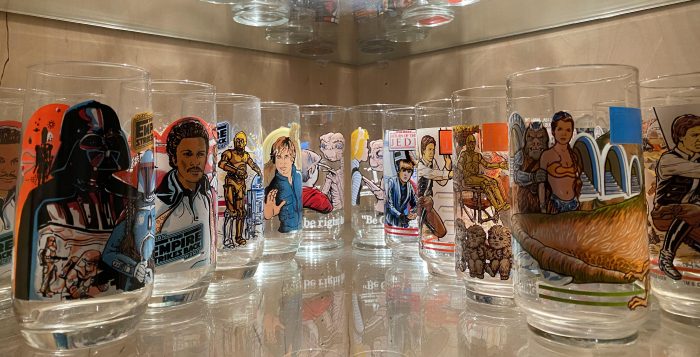
As far back as I can remember, I always wanted to be a Goonie.
To me, being a Goonie was better than being President of the United States. Even before I first wandered into the theater for an after-school job, I knew I wanted to be a part of them. It was there I belonged. To me, it meant being somebody in a neighborhood full of nobodies. They weren’t like anyone else. They did whatever they wanted in the Goon Docks. They’d double-park their bicycles in front of Lower Columbia Bowl and nobody ever gave them a ticket. In the summer when they played video games all night, nobody ever called their parents.
It was a glorious time. Goonies were all over the place. It was before The Avengers and before Kylo Ren decided to take on a Sith Lord. It was when I met the world. Saturday night was for second run matinees, but Friday night at the theater was always for the first run showings.
It was easy for all of us to disappear in these films. My childhood home may as well have been listed in Spielberg’s name, my VHS tapes displaying his extensive filmography. My movie memorabilia collection was vast. I never didn’t enjoy a theatrical experience. I didn’t have to pay taxes yet. My birth certificate and Social Security Number were all you’d need to know I was alive. I was young. They were simpler times.
Isn’t “growing up” part of balancing nostalgia with reality? The realization that we aren’t invincible children anymore happens at a certain point between puberty and adulthood. These films are also accessible to every generation, creating, in a sense, a nostalgia for nostalgia itself. As a society, we are fascinated by how elders lived. What it was like for them growing up, and their elders before them? We tend to imagine childhoods before our time as more full of wonderment and simplicity than our own. A time of unbridled optimism, one that’s partly created and perpetuated by film. Made up. Projected onto our subconscious like a possessed reel-to-reel. Nostalgia doesn’t solely regard one’s own formative years. That’s why we fantasize about periods in history during which we never lived. Movies compound this feeling by sensationalizing the past. And that’s alright. As long as the lines between fiction and nonfiction remain rigid.
I’m all grown up now, but hey – at least I have visual markers such as my The Goonies Godfather’s Pizza promotional glasses from 1985. They’re part of my larger collection of promotional film glasses from 1977-2019, mostly from fast-food chains (blockbusters and successful franchises’ merchandise at popular North American food joints are a marketing win-win for both parties involved).
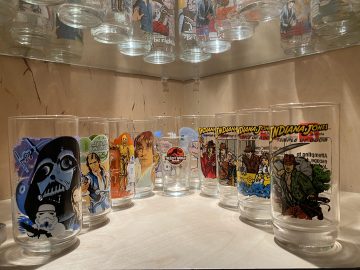
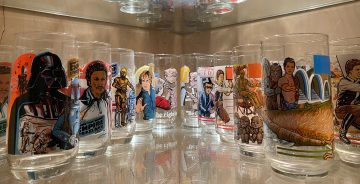
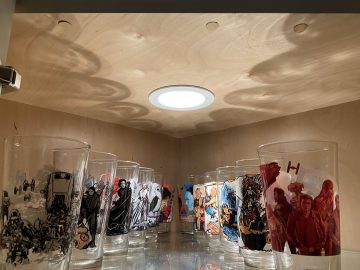
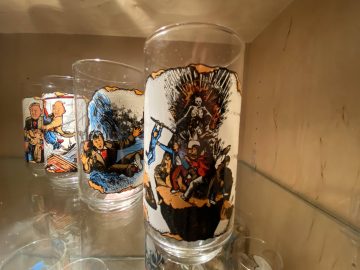
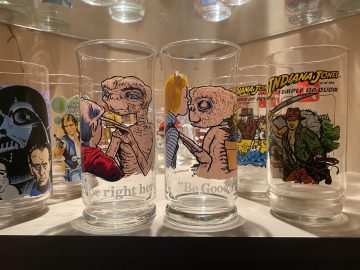
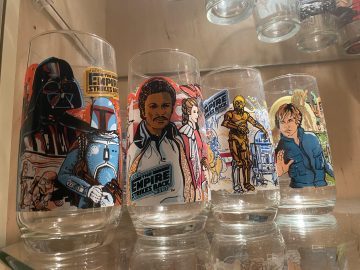
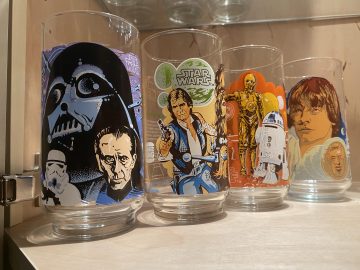
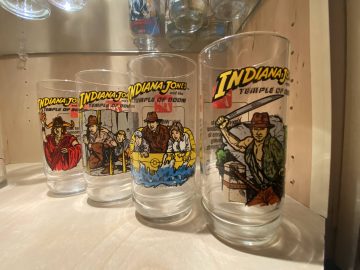
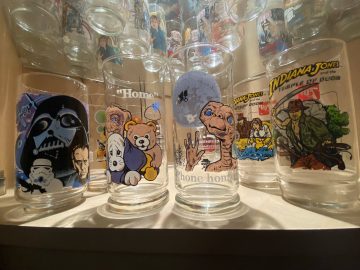
My other sets include Star Wars: Episode IV – A New Hope (at the time, just Star Wars), Star Wars: Episode V – The Empire Strikes Back (the larger versions, and the standard button glass versions sans Darth Vader, which were only sold in Ohio), and Star Wars: Episode VI – Return of the Jedi sets – all 15 issued by Burger King and Coca-Cola in 1977, 1980, and 1983, respectively. There’s the complete E.T. set, issued by Pizza Hut in 1982, the Star Wars: Episode VII – The Force Awakens glass designed by Mondo, the Rogue One: A Star Wars Story glass designed by Martin Ansin, all three Star Wars: Episode VIII – The Last Jedi glasses and the Solo: A Star Wars Story designed by artist Oliver Barrett, and both Star Wars: Episode IX – The Rise of Skywalker glasses by artist César Moreno, all issued by Alamo Drafthouse, Mondo, and Coca-Cola Zero Sugar in 2015, 2016, 2017, 2018, and 2019, respectively. There’s also Indiana and the Temple of Doom, issued by 7-Up and Taco Bell, Taco Time (they only offered two out of the complete set of four), Brown’s Chicken, McDonald’s, and even In-N-Out, and two smaller, sake-portioned The Lost World: Jurassic Park glasses, issued by Kirin, only sold in Japan in 1997. This item is the only traditional promotional glass of the original trilogy, paired with its ‘97 release in Japan. With simply the logo painted onto it, the glass speaks for itself.
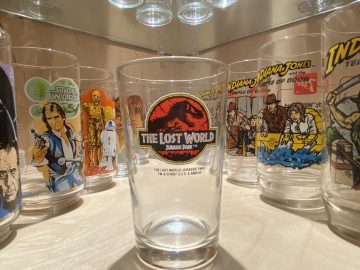
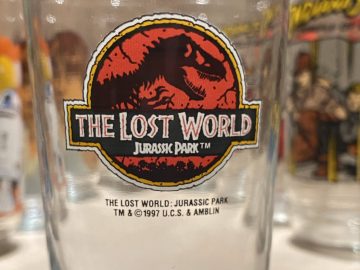
The Ohio-sold Empire Strikes Back Darth Vader button glass from the Burger King collection is the only glass I’m still actively searching for. But that’s part of the ride. Not only searching the web, but also stumbling upon antique shops, second-hand and thrift stores, garage sales, and flea markets. The search – the Goonies-esque adventure – is half of the fun of collecting.
Interestingly, with the exception of my Star Wars collection (George Lucas’ Star Wars is very much a part of that nostalgic era of innovative blockbuster filmmaking), all of my glasses come from Steven Spielberg films. And those films beautifully and systematically tap into our collective love for nostalgia: a yearning for an ethereal, elusive past that never quite was. And these particular pieces of film history capture that nostalgia in a glass (pardon the pun) – they are extensions of that feeling these films evoke.
When I’m looking at my collection, I feel a little bit closer to Mikey (Sean Astin), Chunk (Jeff Cohen), Data (Ke Huy Quan), Brand (Josh Brolin), Andy (Kerri Green), Stef (Martha Plimpton), Mouth (Corey Feldman), and Sloth (John Matuszak). I feel closer to the world of The Goonies, E.T., Indiana Jones, Star Wars, and Jurassic Park. I can feel a palpable sense of movie magic when I have them on display in my home, when I analyze each brilliant artist’s intricate design, painting a specific, memorable scene or piece of imagery from the given film. Each of these sets (and this is typical of vintage promotional glasses in general), with the exception of the Alamo Drafthouse glasses, uses four glasses in order to provide a detailed synopsis of the given film they’re promoting in four distinct chapters. Why not three to follow the traditional three-act narrative structure of film? Likely because an even number sounds cleaner than an odd number, and to account for character intros and additional, integral story elements.
“Every picture tells a story, don’t it?” said the great Rod Stewart.
Allow me, if I may, to transport you to the summer of ‘77. Star Wars broke box office records, surpassing the cast and crew’s wildest expectations. It was a worldwide sensation. A defining moment in history and in shaping pop culture and our current ideology. This launched a decades-long merchandising campaign for the uber-successful franchise that continues to bring in continuous revenue and help ticket sales today. It began with Burger King and Coca-Cola, two of the mainstays of exorbitant Americana, which began giving away Star Wars glasses along with purchases of certain items on Burger King’s menu.
Each glass has a narrative, literally and figuratively. At a certain point in history, an eager fan had enough meals at Burger King to collect all four. At another point in time, a collector may have found these same four glasses at a flea market or garage sale after the eager fan grew up and his love for Star Wars faded. Years later, that collector may have sold that formerly bright-eyed and bushy-tailed fan’s glasses to me on eBay. Who knows what may happen to them in the future, but I don’t plan on getting rid of them anytime soon.
And then, of course, there are the literal narratives depicted in the artistry itself, accompanied by captions.
Star Wars
For the ’77 Star Wars collection, Burger King had C-3PO (Anthony Daniels) and Artoo Detoo (Kenny Baker) – spelled out like Lucasfilm did in the marketing of the first film – on Tatooine on one glass; Luke Skywalker (Mark Hamill), Princess Leia (Carrie Fisher), and Obi-Wan Kenobi (Alex Guinness) against the backdrop of the Death Star, a TIE Fighter, an X-Wing, two Stormtroopers, and a bird’s eye view of planet Tatooine on a second; Darth Vader, a stormtrooper, and Wilhuff Tarkin (Peter Cushing) against the backdrop of the Death Star as a TIE Fighter flies in the distance on a third; and Han Solo (Harrison Ford) and Chewbacca (Peter Mayhew) inside the Millennium Falcon and a smaller Luke and Obi-Wan against the backdrop of the three moons of Kashyyyk as an X-Wing flies in the background to compete the set.
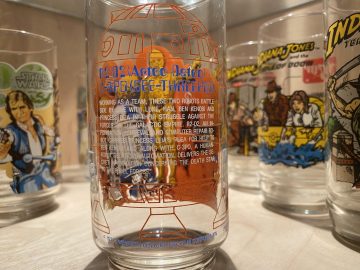
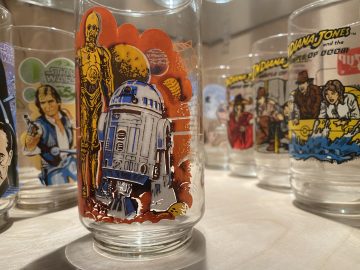
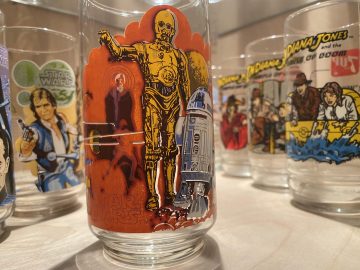
“Working as a team, these two robots battle side by side with Luke, Han, Ben Kenobi, and Princess Leia in their struggle against the forces of the Galactic Empire. R2-D2, and information retrieval and computer repair robot, carried Princess Leia’s Plea for help to Ben Kenobi, and along with C-3P0, a human-robot relations automation, delivers the secret information concerning the Death Star to the Rebel Forces.”
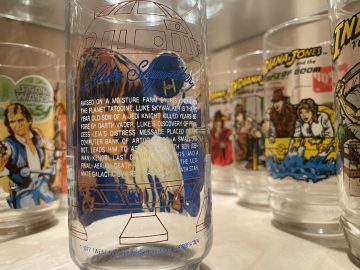
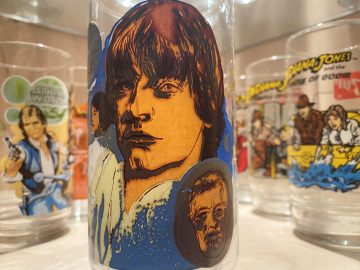
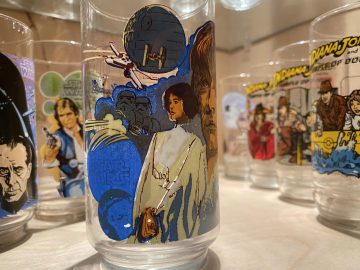
“Raised on a moisture farm by his uncle on the planet Tatooine, Luke Skywalker is the 20 year old son of a Jedi Knight killed years before by Darth Vader. Luke’s discovery of Princess Leia’s distress message placed in the computer bank of Artoo Detoo, a small robot, leads him to association with Ben (Obi-Wan) Kenobi, last of the Jedi Knights, and a final aerial struggle with the ultimate galactic weapon, the Death Star.”
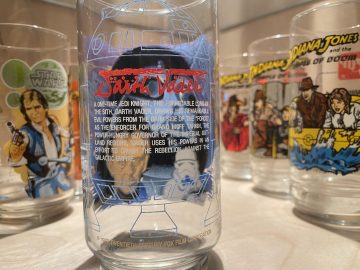
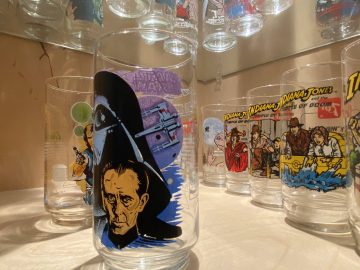
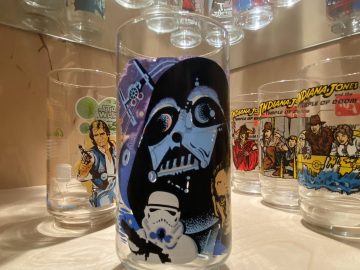
“A one-time Jedi Knight, the formidable Lord of the Sith, Darth Vader, draws his remarkable evil powers from the Dark Side of the “Force.” As the enforcer for Grand Moff Tarkin, the power-hungry governor of the Imperial Outland Regions, Vader uses his powers in an effort against the Galactic Empire.”
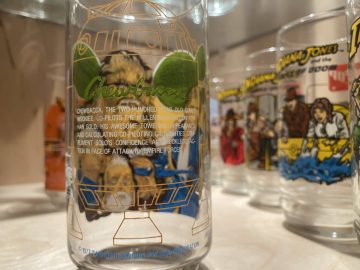
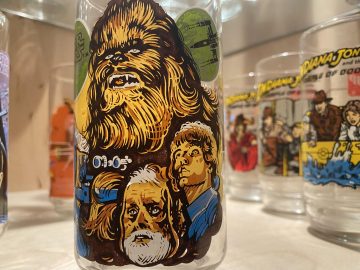
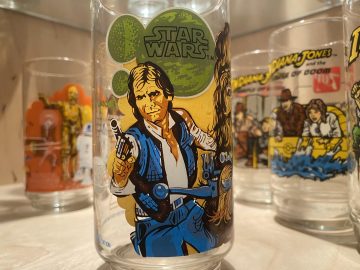
“Chewbacca, the two hundred year old giant Wookiee, co-pilots the Millennium Falcon for Han Solo. His awesome towering appearance and calculating co-piloting capabilities compliment Solo’s confidence and reckless action in the face of attack by Empire forces.”
The Empire Strikes Back
For the ’80 Empire Strikes Back collection, Burger King commissioned C-3PO, R2-D2 (no longer spelled out by the 1980s), and Han Solo riding a Tauntaun on the snow plains of Hoth on a one glass; Lando Calrissian (Billy Dee Williams), a smaller Leia and Han, and two stormtroopers on Cloud City featuring a Storm IV Twin-Pod cloud car soaring in the background on a second; Luke, Yoda (Frank Oz), and R2-D2 on planet Dagobah, with a smaller Luke and Yoda training upside down in the background on a third; and Darth Vader, two of his Special Force Stormtroopers, and Boba Fett against the backdrop of Cloud City to complete the set.
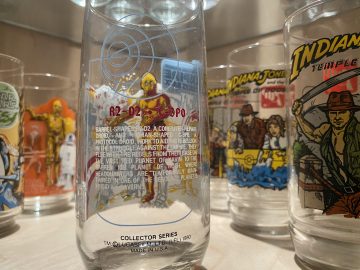
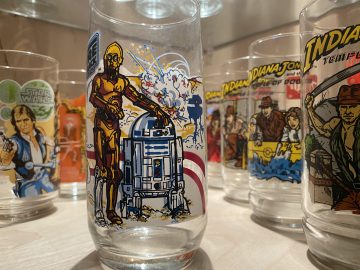
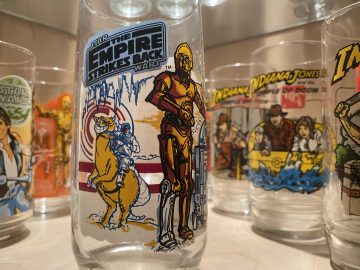
“Barrel-shaped R2-D2, a computer-repair droid, and human-shaped C-3PO, a protocol droid, work to aid the rebellion in the struggle against the Empire. They flee with the Rebels from their base on the vast red planet of Yavin to the barren ice planet of Hoth, where headquarters are temporarily maintained in one of the desolate planet’s frigid ice caverns.”
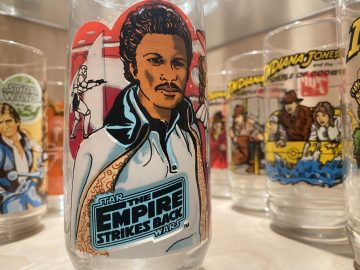
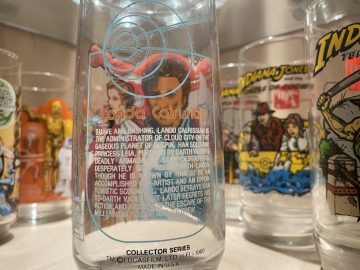
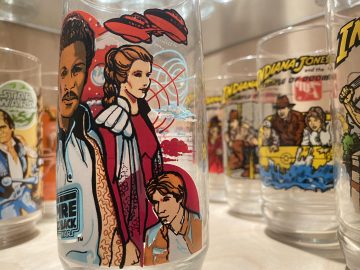
“Suave and dashing, Lando Calrissian is the administrator of Cloud City on the gaseous planet of Bespin. Han Solo and Princess Leia, pursued by Darth Vader’s deadly armada of star destroyers, desperately seek refuge with Lando, though he is known by Han to be an accomplished con-artist and an opportunistic scoundrel. Lando betrays Han to Darth Vader, but later regrets his action and assists in the escape of the Millennium Falcon and its crew.”
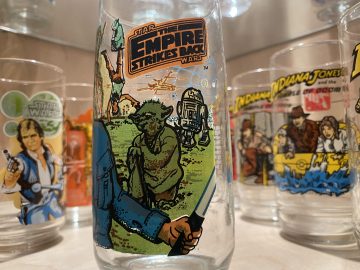
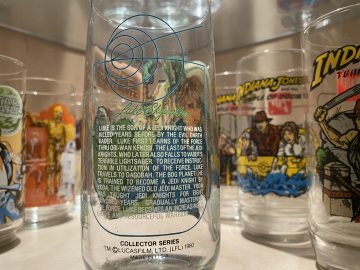
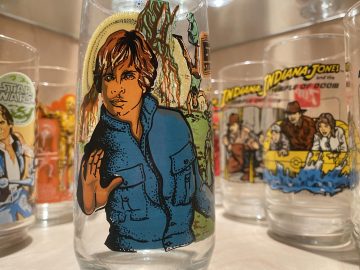
“Luke is the son of a Jedi Knight who was killed years before by the evil Darth Vader. Luke first learns of the Force thru Obi-Wan Kenobi, the last of the Jedi Knights, who later also falls to Vader’s terrible lightsaber. To receive instruction in utilization of the Force, Luke travels to Dagobah, the bog planet. He is trained to become a Jedi Knight by Yoda, the wizened old Jedi Master. Yoda has taught Jedi Knights for eight hundred years. Gradually mastering the Force, Luke becomes an increasingly brave and resourceful warrior.”
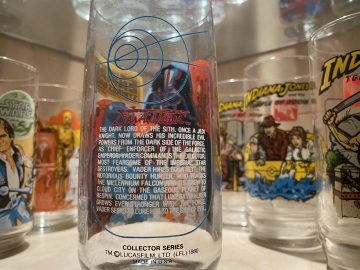
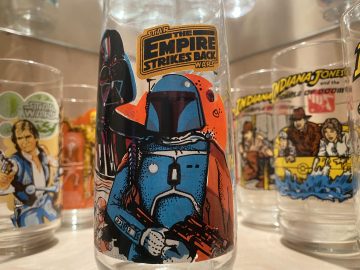
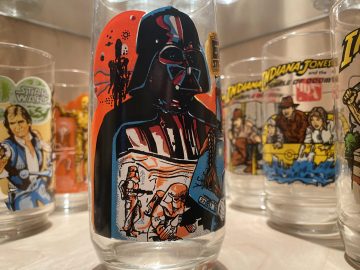
“The Dark Lord of the Sith, once a Jedi Knight, now draws his incredible evil powers from the Dark Side of the Force. As Chief Enforcer of the Galactic Emperor, Vader commands the Executor, most fearsome of the Imperial Star Destroyers. Vader hires Boba Fett, the notorious bounty hunter, who tracks the Millennium Falcon and its crew to Cloud City on the gaseous planet of Bespin. Concerned that Luke Skywalker grows ever-stronger with the Force, Vader seeks to lure him to the side of evil.”
Return of the Jedi
For the ’83 Return of the Jedi collection, Burger King included Princess Leia held captive at Jabba the Hutt’s palace on Tatooine, with a Gamorrean restraining her as jester Salacious Crumb mocks her and the Max Rebo Band reluctantly plays on one glass; Han Solo with his signature blaster, Luke Skywalker holding his lightsaber above the Sarlacc Pit, and Jabba the Hutt’s Khetanna in flames in the Tatooine desert on a second; C-3PO, Chief Chirpa, Wicket W. Warrick, and three young Ewoks at the Ewok Village on one of the nine moons of Endor on a third; and Luke Skywalker battling Darth Vader (James Earl Jones) on the Death Star while Emperor Palpatine (Ian McDiarmid) watches in the background, a larger Palpatine accompanied by an Imperial Royal Guard and one of his Imperial dignitaries to round out the original trilogy collection.
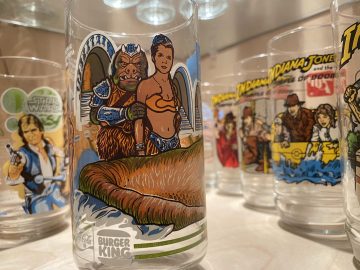
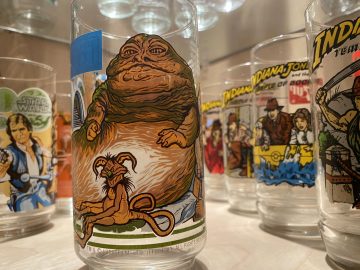
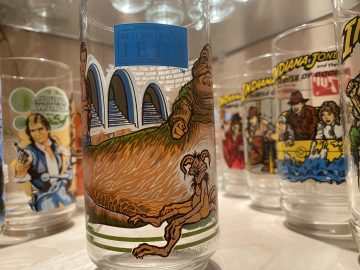
“Intergalactic gangster, Jabba the Hutt, reclines on his throne with Salacious Crumb, while Princess Leia Organa is held captive beside him by a pig-like Gamorrean Guard. The Max Rebo Band provides entertainment for the court.”
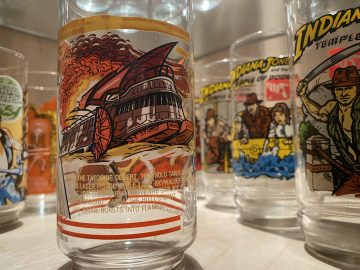
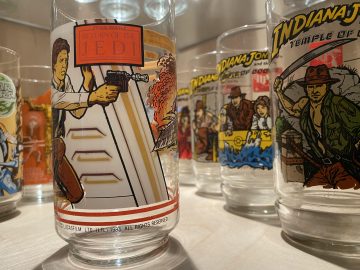
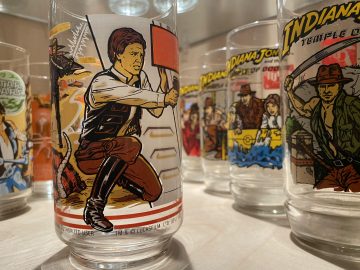
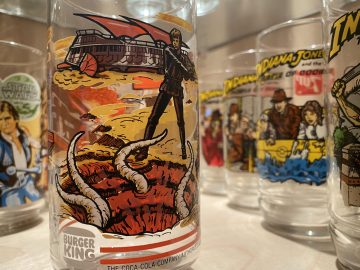
“In the Tatooine desert, Han Solo takes aim with his laser pistol while Luke Skywalker brandishes his Jedi lightsaber above the Sarlacc Pit. In the background, Jabba the Hutt’s giant sail barge bursts into flames.”
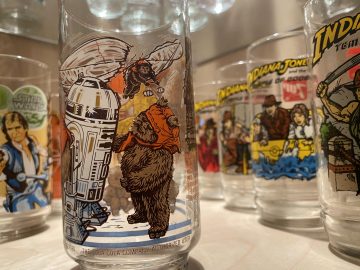
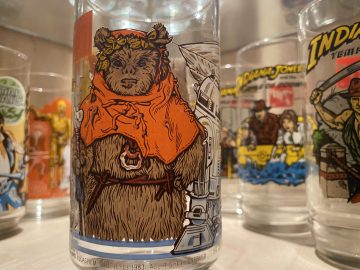
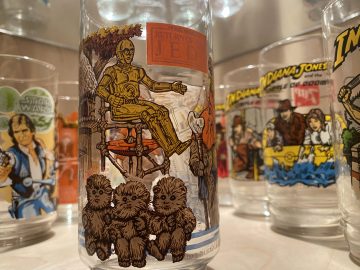
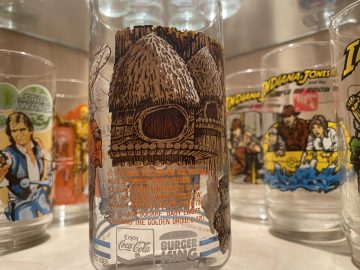
“At the Ewok village on the green moon of Endor, Chief Chirpa holds his staff preparing to go into the forest, while Wicket W. Warrick inspects R2-D2. Over on the village square, baby Ewoks surround the golden droid, C-3PO.”
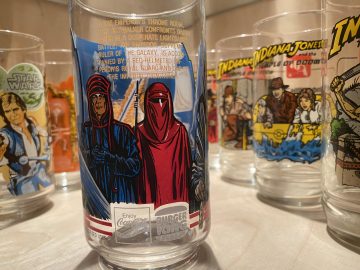
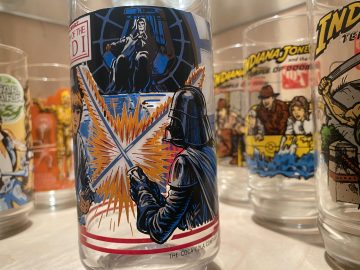
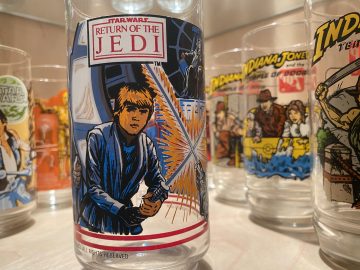
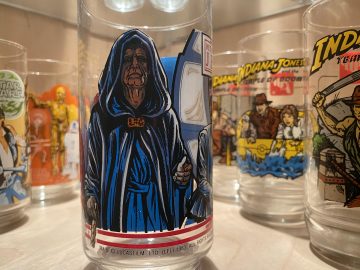
“In the Emperor’s throne room, Luke Skywalker confronts Darth Vader in a desperate lightsaber battle. The Emperor, supreme ruler of the galaxy, is accompanied by a red-helmeted Emperor’s Royal Guard and one of the Imperial Dignitaries.”
The Goonies
These painted-on depictions happen to display some of my favorite scenes in The Goonies. Seeing the former heroes of the Goon Docks revel in their old stomping grounds brings me immense joy, and harkens back to the summer of ‘85, a pivotal time in history for film and sociopolitical significance.
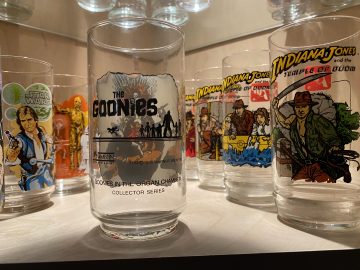
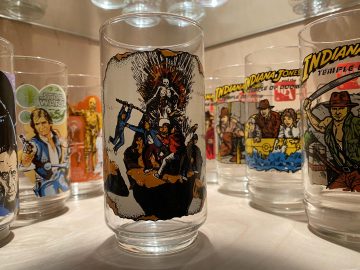
“Goonies in the Organ Chamber”
As a child, I was on the edge of my seat watching this scene, my feet anxiously shaking above the ground below me, and scared out of my size 5 Vans. (Granted, that was before I watched Poltergeist – thanks a lot, Tobe Hooper and Spielberg, for scarring me for life.) Nervous. Excited. Ecstatic. Relieved when the Goonies barely escaped, the Fratellis hot on their tails. It’s fresh. It’s daring (for a PG film). It’s unique (training children to remain calm, using their minds and logic in order to solve problems in the face of crises and conflict). It would also foreshadow an eerily similar scene in Spielberg’s Indiana Jones and the Last Crusade in 1989.
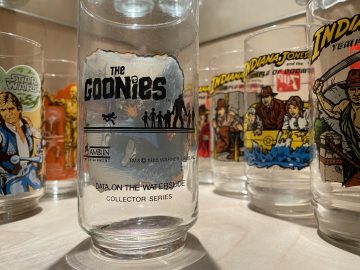
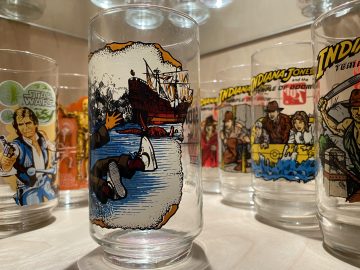
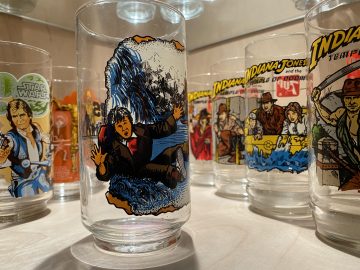
“Data on the Waterslide”
First of all, who wouldn’t want to go on this waterslide? Forget Typhoon Lagoon, Blizzard Beach, Aqautica, or Hurricane Harbor. I’m starting a campaign to build a model of the Waterslide to One-Eyed Willy’s caved-in cove. Dave Grusin’s score elevates this sequence in The Goonies to even further hair-raising heights, and Richard Donner’s iconic scene still gives me chills. Everyone’s face is priceless, but Data looks genuinely terrified, and one has to appreciate the hilarious screen-to-glass accuracy on this collectible.
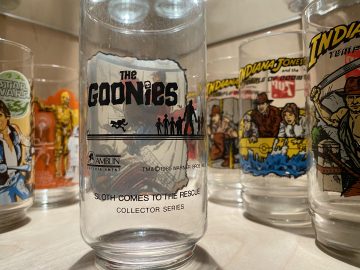
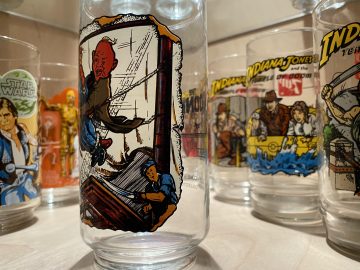
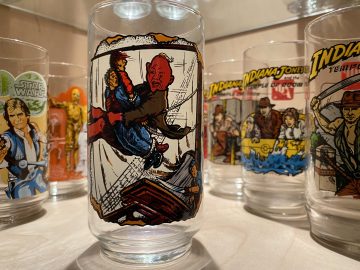
“Sloth comes to the Rescue”
“Hey you guuuuys.” It’s a quote you’ve heard a million times, used in a number of different social scenarios.
Even if you haven’t seen The Goonies, you know this quote, and you’ve maybe even seen this scene reenacted by someone you know at some point in your life. I’ve probably done it at some point. It’s almost a rite of passage. If you’re ever on a rope swing, you basically have to reenact it. That’s a fact. This is also a pivotal moment for Sloth, as he finally builds up the courage to stand up against Mama Fratelli (Anne Ramsey) and his brothers Jake (Robert Davi) and Francis (Joe Pantoliano), who’ve systematically abused him his entire life. It was at this point when Sloth became a Goonie.
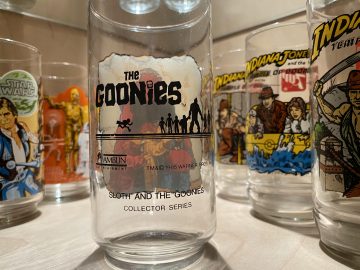
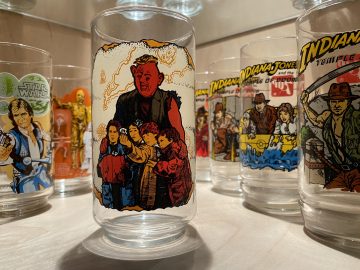
“Sloth and the Goonies”
This is a particularly elusive collectible in the promotional glass collecting world. For one reason or another, it’s typically the last of the four glasses to be added to a collection, if at all. I was lucky to purchase one the moment it was listed on eBay to complete my collection. Right place, right time. I hadn’t seen one listed for years beforehand and I haven’t seen one for sale since. The image of a towering Sloth, hovering over the Goonies, all against a treasure map-inspired backdrop, portraying Sloth as the both the bodyguard and guardian angel of the kids. He is gentle yet strong. Kind, but dangerous when his loved ones are placed in danger. We all, at one point or another, wish we had somebody like Sloth in our lives to protect us from the evils and harsh realities of this world.
Going to the movies isn’t as much of an event as it used to be. It used to be a legitimate social occasion. Gather some friends, load up on snacks, disappear into a cinematic world for 90 minutes, and exchange movie theories afterwards over a couple of games of Pac-Man at the theater arcade. The experience today is largely transactional. The event of the occasion of seeing a film on the big screen has been removed. Fortunately, some theaters across the country (such as The Roxie in San Francisco) are attempting to bring back the theatrical experience of ‘80s past with immense success. It’s more than just popcorn, hot dogs, and soda this time around, it’s gourmet food in a theater kitchen, served to you at your seat. It’s more than just Pac-Man and pinball, it’s a full-service bar, DVD and Blu-ray rental spot, gift shop, and museum of vintage film posters and memorabilia. Sounds a lot like my apartment, now that I mention it.
With the Alamo Drafthouse’s nostalgia-themed theaters, it would make sense that they would bring back the idea of the promotional glass. The Alamo glasses bring quality of design to an entirely new level. The intricate, laser-precision on each pint is a work of artistry in and of itself. Mondo commissions exceptional artists to create endearing homages to iconic films. It’s, again, a continued extension of that collective nostalgia that continually captivates the American zeitgeist.
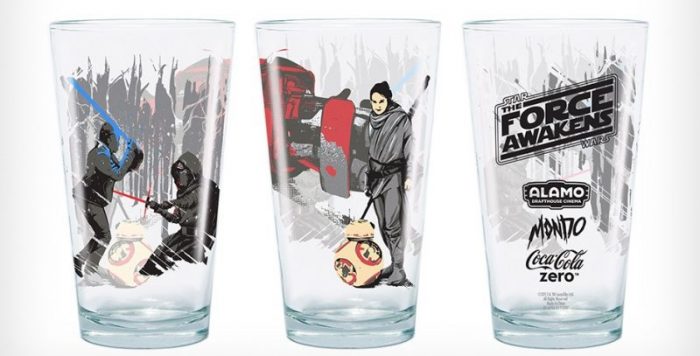
The Force Awakens was Mondo’s most minimalist design. With only one glass offered for purchase with a pre-order ticket, it shows Finn (John Boyega) battling Kylo Ren (Adam Driver) with the Skywalker family lightsaber on the First Order’s Starkiller Base on planet Ilum, and Rey (Daisy Ridley) and BB-8, with Rey’s trusted red speeder in the background.
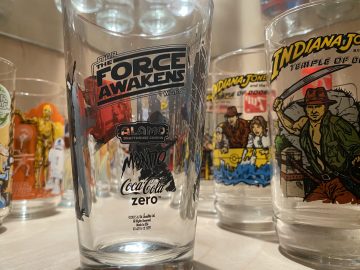
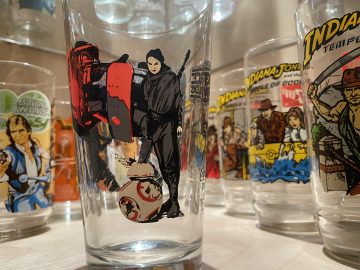
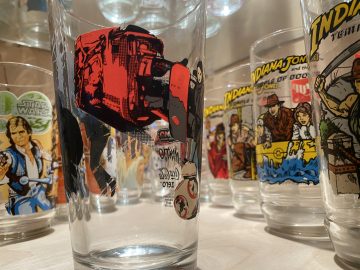
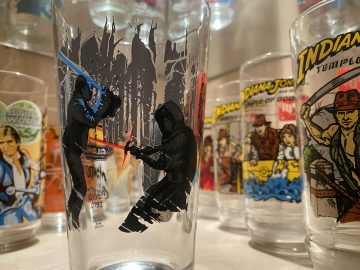
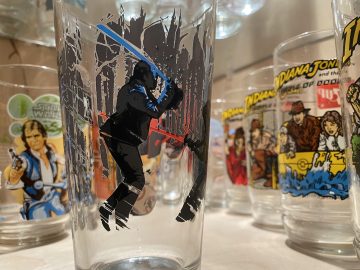
Whereas the original trilogy promoted its pint glasses in fast food chains across Northern America, the sequel trilogy markets its pint in-theater. However, this time around, it’s more exclusive with the Alamo Drafthouse partnership – glasses run out fast, and they’re expensive. It was the same level of exclusivity with these throwback promotional pint glasses for Alamo’s Rogue One, Solo, three The Last Jedi, and two The Rise of Skywalker glasses. These included considerably more detail.
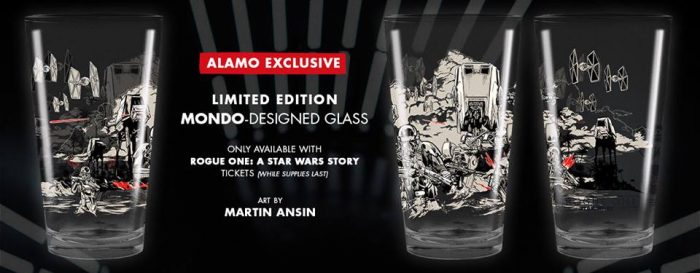
Much like Rogue One: A Star Wars Story’s darker tone, artist Martin Ansin chose a muted color palette for this glass, with every object and character black, grey, and white, signifying the moral no man’s land in the Star Wars universe.
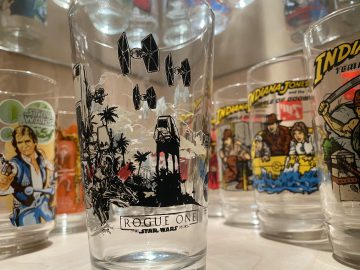
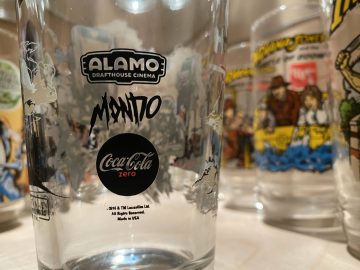
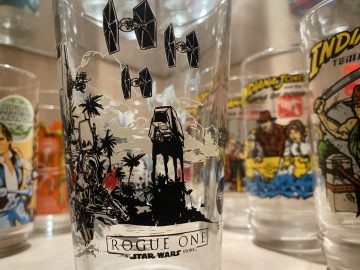
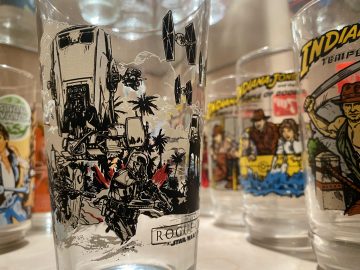
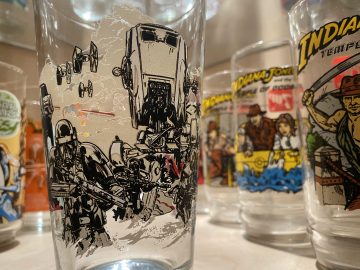
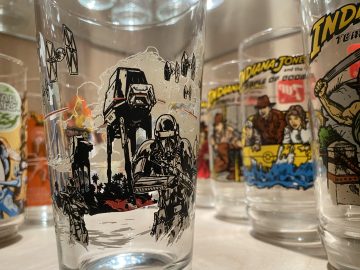
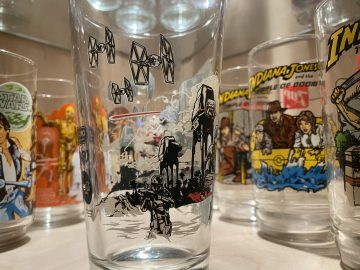
The glass has four Stormtroopers, three AT-ACTs, and one AT-ST in the foreground, and six TIE Fighters in the background on the fallen desert moon of Jedha. The only color is red, signifying the destruction the vehicles of the Galactic Empire leave in their wake.
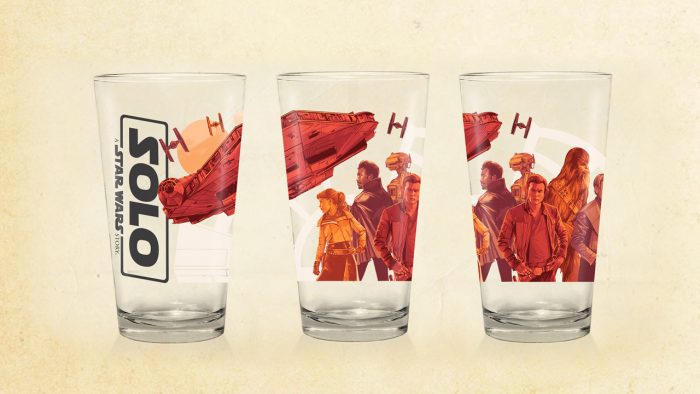
Simple yet effective. Artist Oliver Barrett’s red-orange soaked landscape evokes the American Westerns that Solo: A Star Wars Story harkens back to. Hot, dry desert locations. Shootouts. Robberies.
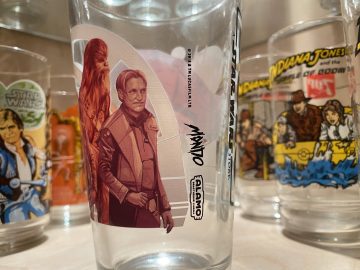
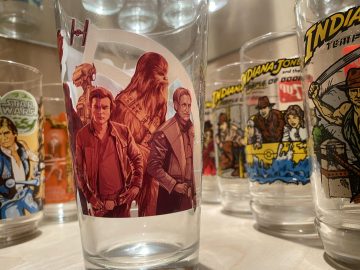
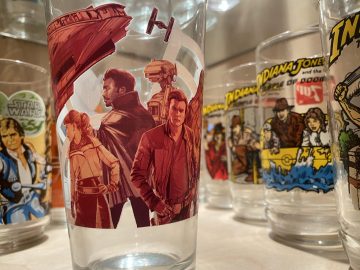
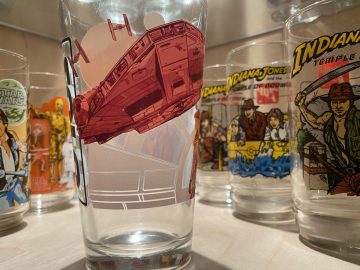
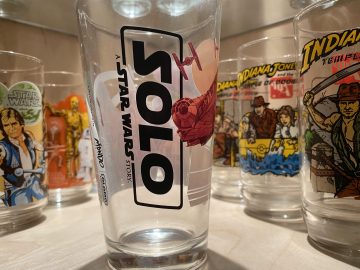
The glass depicts Han (Alden Ehrenreich), Chewbacca (Joonas Suotamo), L3-37 (Phoebe Waller-Bridge), Lando (Donald Glover), Qi’ra (Emilia Clarke), and Tobias Beckett (Woody Harrelson) on Dryden Vos’s (Paul Bettany) yacht First Light as a prominent Millennium Falcon flies in the foreground and two TIE Fighters fly in the distance against a backdrop of a setting Vandor sun.
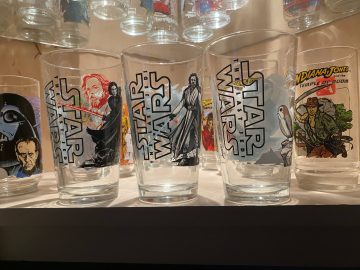
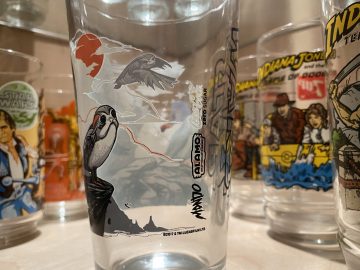
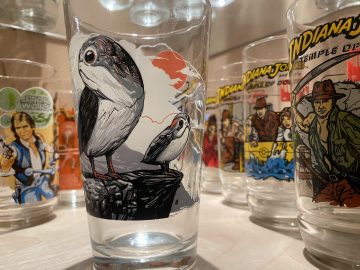
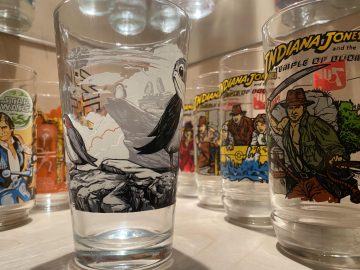
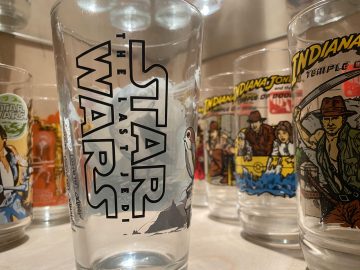
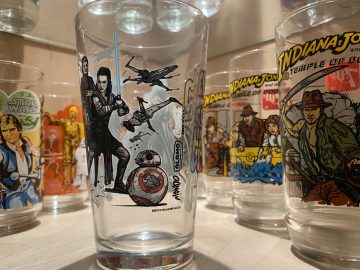
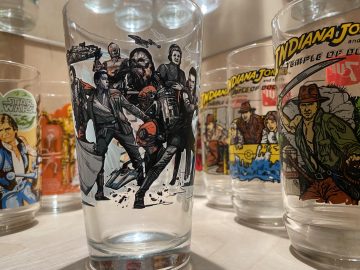
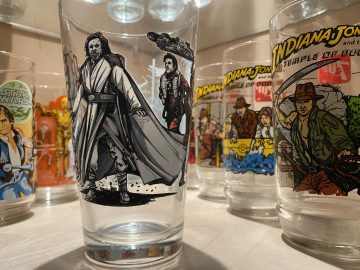
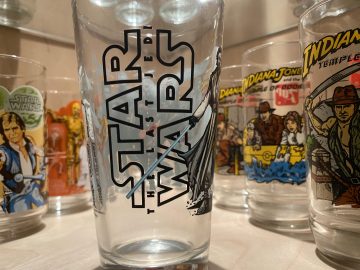
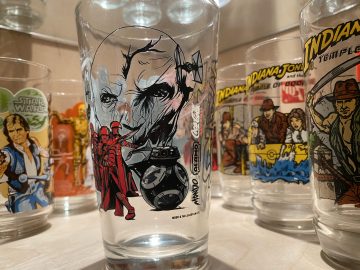
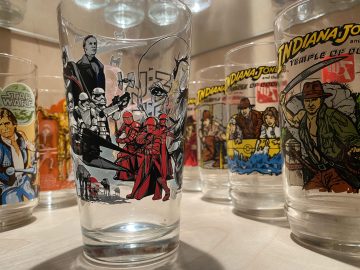
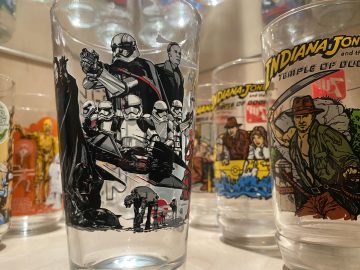
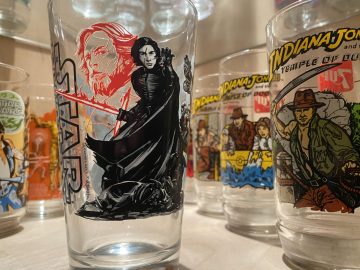
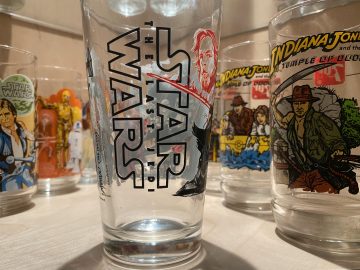
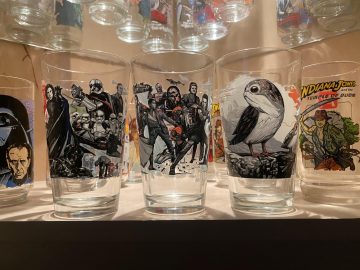
The Light Side
Oliver Barrett is back with three The Last Jedi glasses, and they are a sight to behold. One Light Side, one Dark Side, and one Porg side (a highly anticipated creature introduced into the Skywalker Saga). It features cinematically shaded-in paintings of a confident Rey wielding the Skywalker family lightsaber with BB-8 by her side, protecting General Organa, Chewbacca, Maz Kanata (Lupita Nyong’o) Admiral Ackbar (Tim Rose), C-3P0, R2-D2, and Finn, while solitary Luke brandishes the same lightsaber on the other side of the glass, ready to challenge an enraged Kylo Ren on the Dark Side glass. There’s the Millennium Falcon, an Incom T-70 X-Wing (the Resistance’s update of the Rebel Alliance classic) resembling Luke’s old X-Wing, and, interestingly, a Y-Wing, an A-Wing, and two B-Wings, even though the Resistance never uses these ships of the Rebel Alliance some 30 years prior. Perhaps it’s Barrett’s stealth homage to the original trilogy. Or his way of articulating that the Resistance only has a fraction of the resources it once had.
The Dark Side
Kylo Ren wields his homemade, crossguard lightsaber as he faces the solitary Luke on the Light Side glass, holding his hand up so as to attempt to mind probe the Jedi Master, as General Hux (Domhnall Gleeson), Captain Phasma (Gwendoline Christie), and five Stormtroopers lurk behind him. The leader of the First Order’s opponent watches over him from above in his true, haggard form from Temple Island on the planet Ahch-To, while he Force projects himself onto the planet of Crait to confront his former pupil as four AT-M6’s roam ominously in the distance. Meanwhile, three Elite Praetorian Guards prepare to defend Snoke as the First Order’s BB-9E roams in the foreground, while Snoke’s oversized head watches in the background. Three TIE Fighters, the Dreadnought Fulminatrix, and Kylo Ren’s TIE Silencer hover in the distance.
The Porg Side
Five porgs on Temple Island of Ahch-To turn their heads to observe the Millennium Falcon land as one of the planet’s two suns picturesquely sets in the background. What else do you need out of a porg homage?
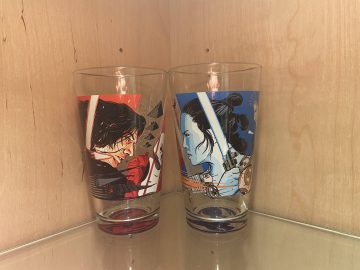
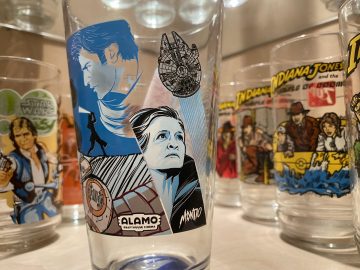
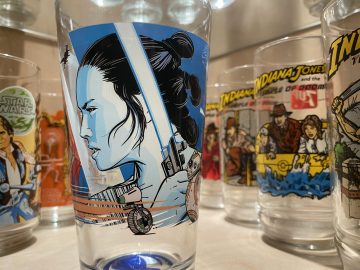
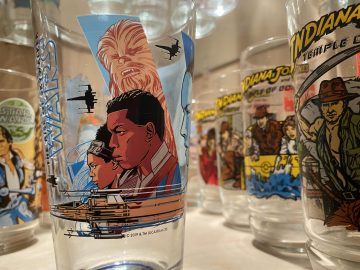
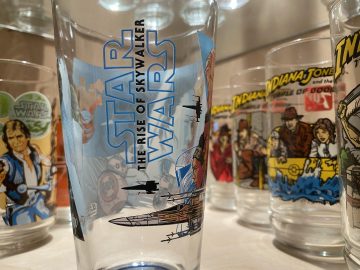
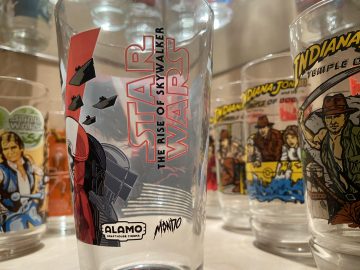
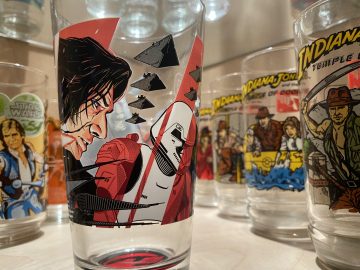
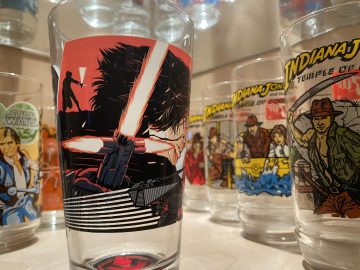
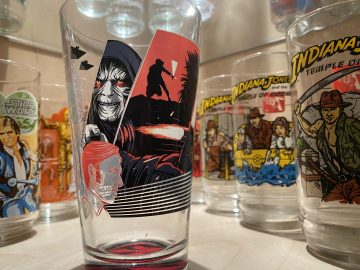
For The Rise of Skywalker, Alamo and Mondo released one Dark Side glass and one Light Side glass each, with César Moreno creating a collective canvas capping the Skywalker Saga in elegant fashion.
The Dark Side
Emperor Palpatine, General Hux, Kylo Ren, brandished lightsaber in hand, a stormtrooper, an Elite Praetorian Guard, and Ap’lek and Kuruk of the Knights of Ren, united under the Final Order, prepare to attempt to silence the Resistance, once and for all, as a smaller Kylo Ren battles an absent Rey on the Death Star ruins in the distance. Eight Final Order Star Destroyers from Exegol and Kylo Ren’s TIE Silencer fly in the background. The First Order has grown into the larger and more powerful Final Order, but the overwhelming red that Moreno saturates each character and object with evokes an image of blind hunger for power – the cause of the Emperor’s first downfall. Each character on this glass is, quite literally, “seeing red.” The bottom of the glass displays the mark of the Final Order.
The Light Side
The Resistance prepares for the fight of their lives as Rey, lightsaber powered on with BB-8 again by her side, in attack stance, as Poe (Oscar Isaac), Finn, General Organa, Chewbacca, and Jannah appear determined to confront the Final Order once and for all, as a smaller Rey battles an absent Kylo Ren on the Death Star ruins. Blue has always been the color associated with the Light Side of the Force. Like his Dark Side glass did with red, Moreno emphasizes the blue in every frame, signifying hope and foreshadowing victory. The Millennium Falcon, three X-Wings, and Luke’s X-Wing, which now belongs to Rey, face the Final Order Star Destroyers on the opposing glass. They are outnumbered, but not for long…I won’t spoil the ending for anybody who hasn’t seen the film yet. The bottom of the glass displays the mark of the Resistance.
The Indiana Jones and E.T. glasses aren’t quite as elusive as the original and sequel Star Wars trilogy and The Goonies collections, but they’re aesthetically gorgeous, nonetheless. Two more Spielberg vehicles, the Indiana Jones franchise, stripped of its adventure and historical fiction lure, is about a boy who grew up too fast. Conversely, E.T., is about the importance of remaining a child at heart and, in appropriate situations, mind, throughout adulthood. However, both stories place profound importance on the reuniting of family and finding one’s home. For this reason, I’ll pair each of the four glasses from Temple of Doom and E.T., respectively, as companion glasses.
All four E.T. glasses have E.T.’s home ship soaring in the background.
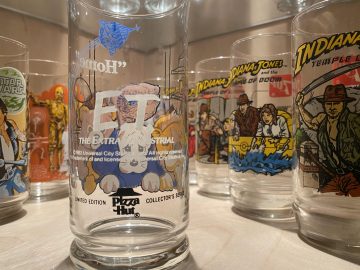
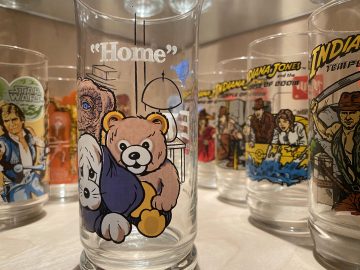
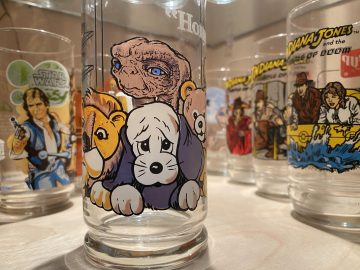
Our first glass has E.T. hiding in Gertie’s (Drew Barrymore) closet with two teddy bears and the family dog. The Temple of Doom companion glass reads, “The spiked room closes in on Indy and Short Round…time to think fast!” As Indy (Ford), Willie (Kate Capshaw), and Short Round (Quan) comically stumble upon a series of increasingly dangerous booby-traps during their first night at the Pankot Palace. I never trusted that Prime Minister Chattar Lal (Roshan Seth). He screamed Thuggee cult.
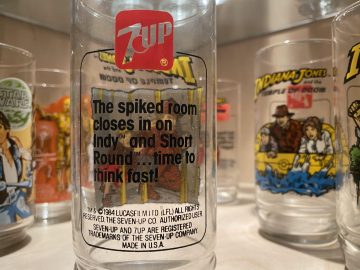
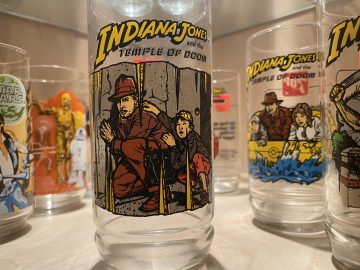
Much like E.T., Indy, Willie, and Short Round are strangers to this new home, hiding from the potential danger of those out to get them. In E.T.’s case, it’s the U.S. government. In Indy and company’s case, they must elude the Thuggee cult’s capture. For both parties, it’s life or death.
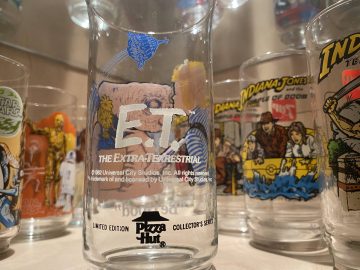
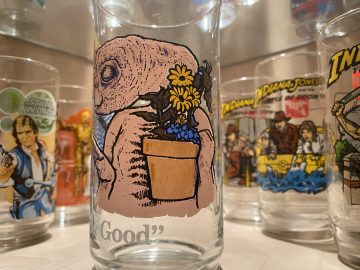
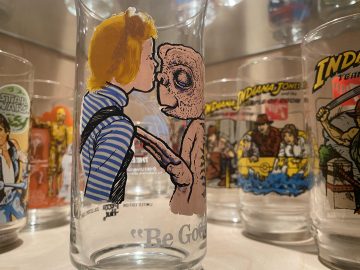
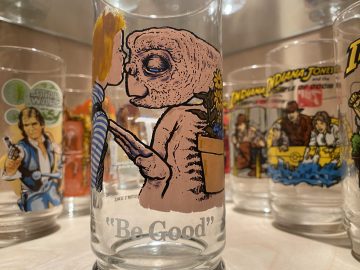
Our second E.T. glass shows the alien embracing Gertie as she kisses his nose next to a pot of the wilted geraniums she gifted him. The Temple of Doom companion glass reads, “Attempting to escape, Indiana Jones turns to fight pursuing Thuggee guards.” Every wondered what would happen if you cut the rope of a suspension bridge? This scene has you covered.
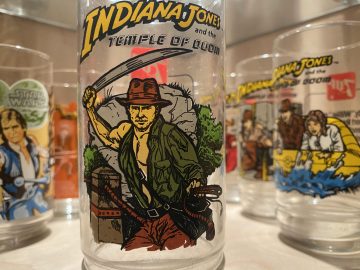
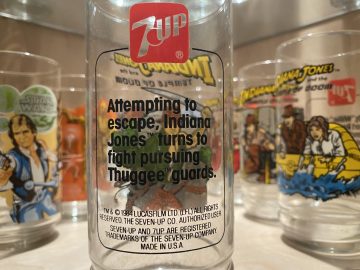
Both the geraniums in E.T. and the Thuggee cult in Temple of Doom represent life, death, and resurrection. These motifs are two of the most integral in either film. The sacrilegious, sacrificial Thuggee act performed by Mola Ram (Amrish Puri) represents death, and the geraniums represent life and resurrection through E.T.’s otherworldly abilities.
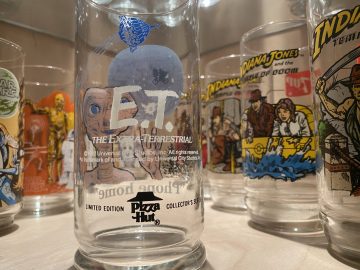
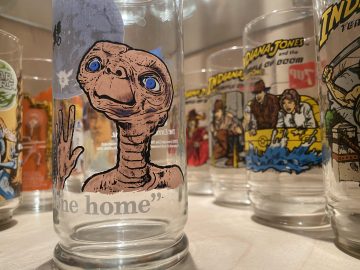
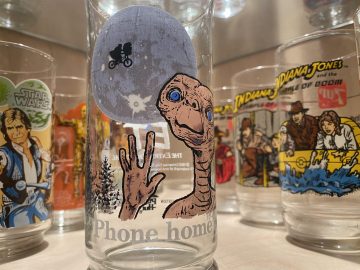
Our third E.T. glass captures E.T. waving in excitement as he and Elliott (Henry Thomas) ride Elliott’s bike across the full moon in the night’s sky: one of the most iconic images in cinema history. If they hadn’t decided to put this scene on one of their promotional glasses, I’d be worried about their marketing team’s savviness. The Temple of Doom companion glass reads, “High priest Mola Ram performs a terrifying Thuggee ritual” as Indy, Willie, and Short Round watch in utter disgust. Using a Sankara, given to humankind by Shiva to protect them from evil, for *checks notes* evil magic by performing human sacrifices to misguidedly invoke the Hindu goddess Kali? Yeah. That has bad karma written all over it.
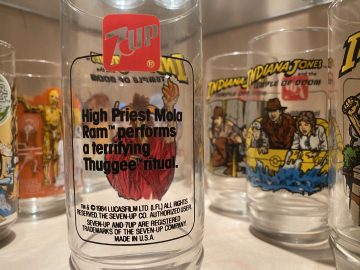
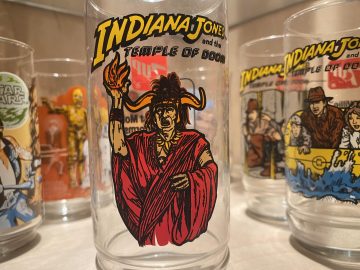
Both of these glasses depict two of the most iconic scenes of not only the 1980s, but also in film history. Elliott and E.T.’s moment is one of unbridled joy, their feeling of pure invincibility palpable for the viewer. Indy, Willie, and Short Round’s moment is one of unrelenting terror, their feeling of utter vulnerability transferring to helplessness for the viewer.
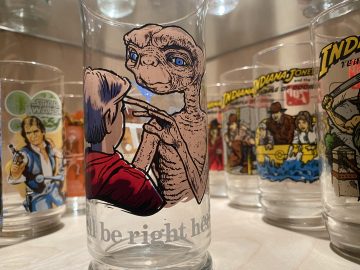
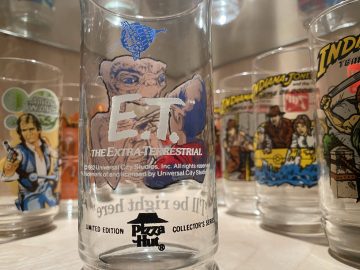
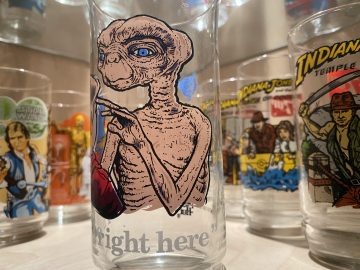
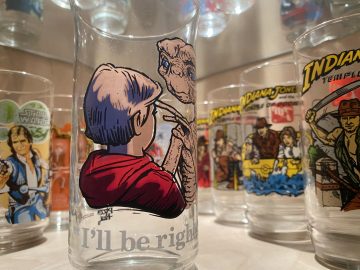
Our final E.T. glass depicts the extraterrestrial touching Elliott’s forehead as his finger lights up. Their last goodbye. Their final, mutually life-changing moment together. The Temple of Doom companion glass reads, “Indy, Willie, and Short Round are drenched as their life raft hurtles down the river rapids.” After crime boss Lao Che (Roy Chiao) attempted to crash their plane in the Himalayas, the journey begins into Mayapore, and, eventually, Pankot Palace, to retrieve the missing Sankara stone.
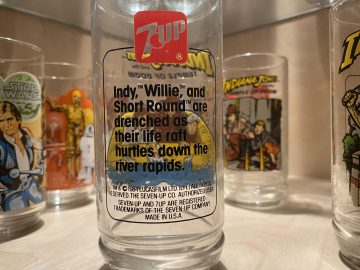
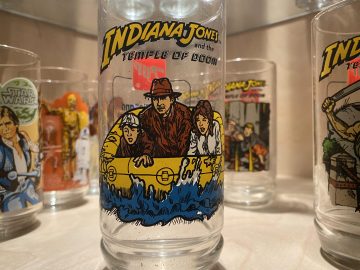
One glass portrays a bittersweet ending to a family adventure film, and one glass captures the adrenaline-inducing beginning to a family adventure film.
Beyond nostalgia. Beyond Spielberg. What is the tangible glue that holds all of these films together (aside from Grusin’s decidedly John Williams-esque The Goonies score)? John Williams. A student of twentieth century harmony, his music stands the test of time. Fifth jumps. Brobdingnagian, brazen harmonies. Modulating parallel major chords around, effortlessly maneuvering around keys. He also pioneered infusing emotion into classical orchestral scores. His way of jumping between fourths (merely an inverted fifth), fifths, and octaves allows him to hover between minor and borrowed keys among the majority of major keys, allowing him to change a theme’s tone on a dime, infusing unexpected musical detours that affect our serotonin levels as we listen to his scores while watching the accompanied scenes on screen. His intuitive ability to pair music with scene is unparalleled. Fans and detractors alike know his themes. It’s infused into the inherently nostalgic engine of popular culture. He won the Oscar for Best Original Score for the first Star Wars and E.T., and was nominated for every film in the original and sequel Star Wars trilogies, as well as for the first three Indiana Jones films.
I’m grateful for my collection. Not only for its constant reminder of my love for these films and its ability to transport me back in time, but also because it’s allowed me to join a new community of likeminded collectors (believe it or not, there’s a Promotional Glass Collectors Association, which I ecstatically joined during my procurement process for my The Goonies collection). Williams, Spielberg, Lucas, and a fortuitous frenzy of consumerism at the onset of the economic boom of the ‘80s during Reagan’s presidency were the perfect ingredients to create a separate world in and of itself. A world apart from the movie fandom. One where nostalgia junkies frantically search for relics of a time when going to the movies meant escaping to another world that seemed different enough from the one we’re living in now.
The lines between reality and fantasy are now blurring as our world spirals out of control. Global political corruption. Mishandled pandemics. International civil rights protests. So we frantically search for physical remnants of a time when the theatrical experience had more meaning. When films seemed larger than life on the big screen. When our worries were kept at bay with the help of our favorite Spielberg and Lucas characters. I just happened to find some meaning at the bottom of a glass. How about you?
The post An Ode to Souvenir Pint Glasses, the Most Nostalgic Form of Movie Fandom appeared first on /Film.
from /Film https://ift.tt/2YFmWcY
via IFTTT
Comments
Post a Comment